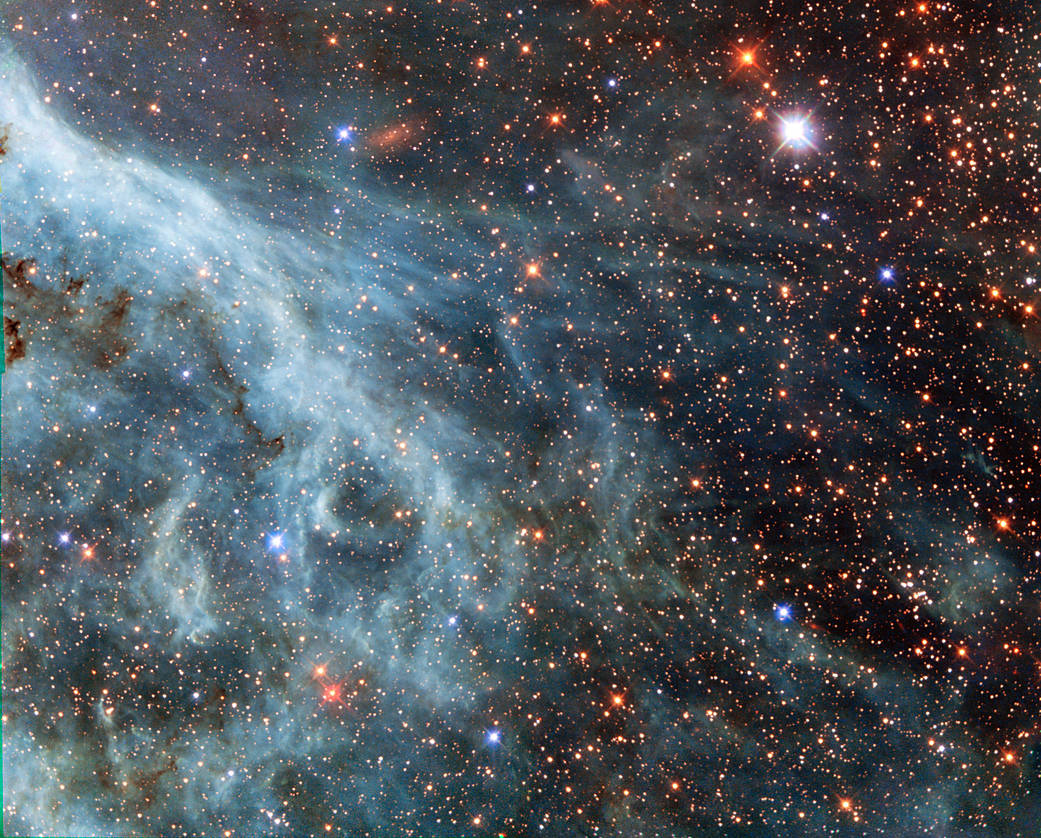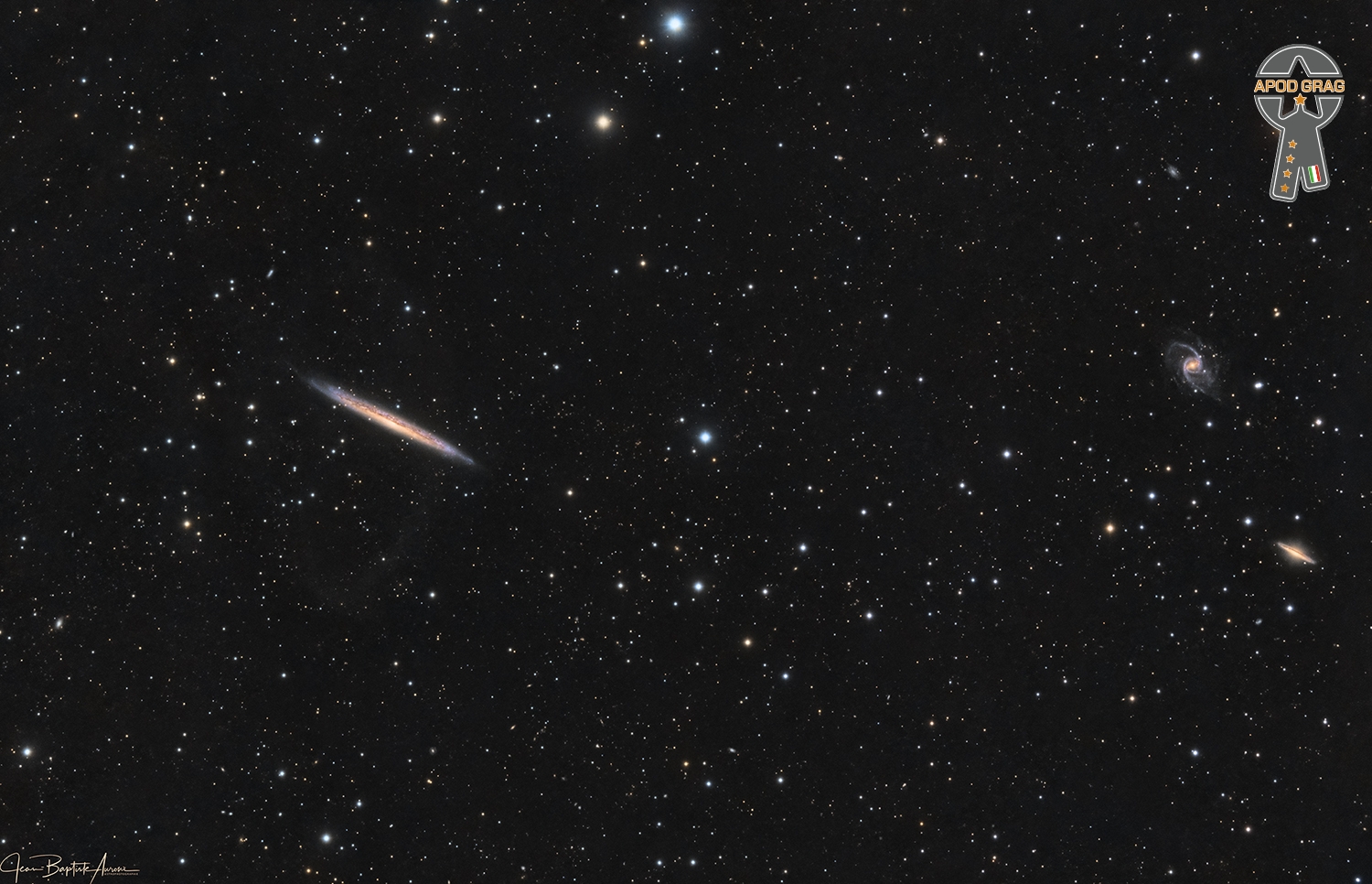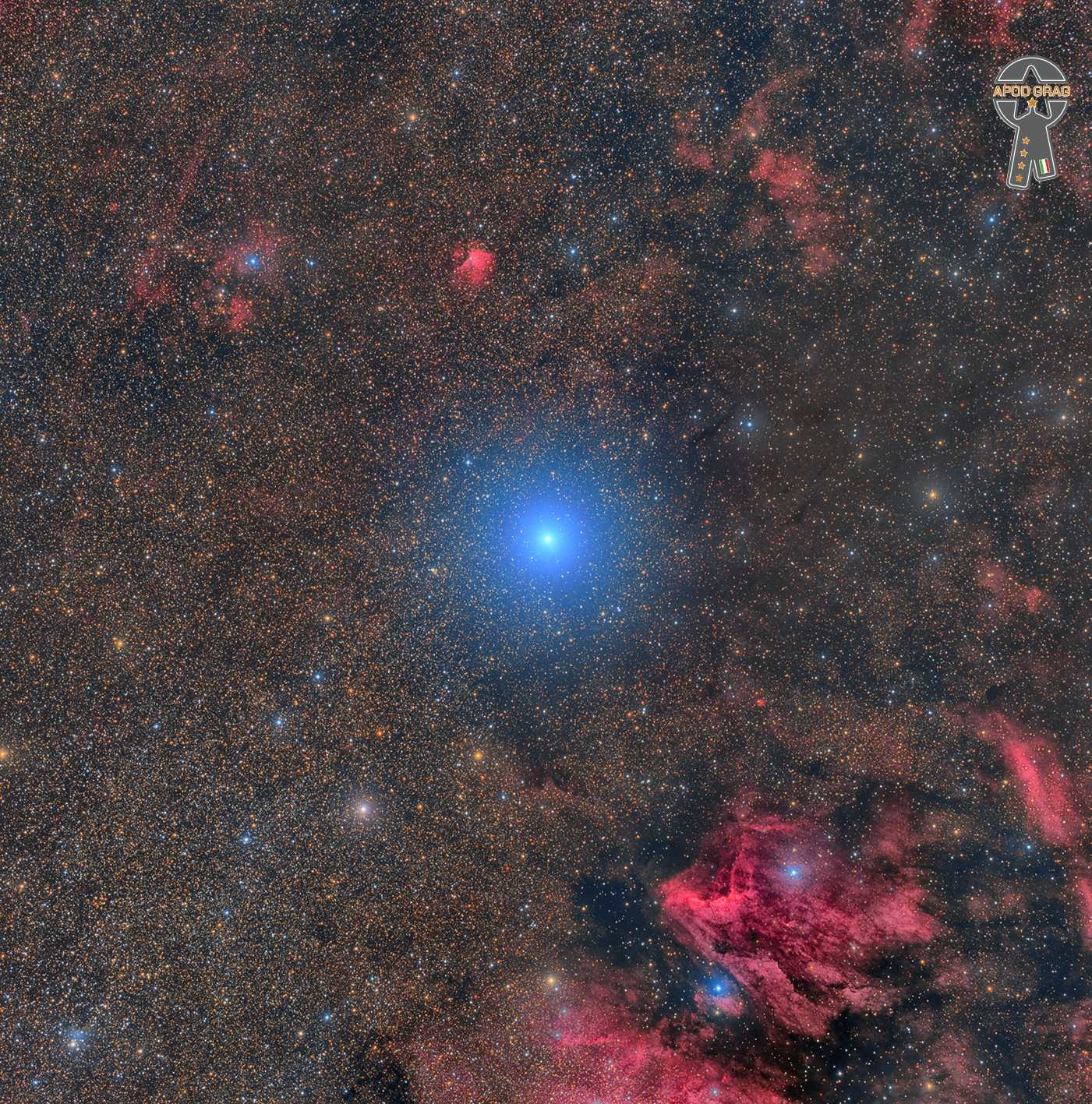Blog
The Eta Aquariids meteor shower, which peaked in early May this year, was captured in this stunning image by astrophotographer Petr Horálek. It was taken near San Pedro de Atacama, a Chilean town about 50 km away from the Chajnantor observatory site, where APEX and ALMA, astronomical facilities co-owned by ESO, are located. The Eta Aquariids meteors are caused by leftover debris from Halley’s comet and make up the bright, arrow-like darts of light in the photo. But don’t stop there: this image is literally full to the brim of astronomical phenomena. The luminous object towards the bottom of the sky is Venus. Above it, arranged in a satisfying line, are several planets in conjunction. Directly above Venus is Jupiter, followed by the bright red Mars, and then Saturn. Conjunctions such as this are rare, often occurring decades apart. The planets also trace the zodiacal light, the faint glow stretching like a pillar, up towards the bright stellar-dense centre of the Milky Way, our home galaxy. Zodiacal light is often seen from dark sites like ESO observatories just after sunset, or before sunrise, and is the reflected sunlight from dust particles in the plane of the Solar System. The dust comes from asteroids, passing comets, and even from other inner Solar System planets, such as Mars. Here we see the zodiacal light paired with the red sunset over the mountains and volcanoes surrounding the Chajnantor site, a spectacular backdrop to this dreamy night sky. Link Annotated version of this image


The Handmaids Tale has manifested in reality. A dystopia following a Second American Civil War wherein a theonomic, totalitarian society subjects fertile women, called “Handmaids”, to child-bearing slavery.
more...William Harrison Withers Jr. (July 4, 1938 – March 30, 2020) was an American singer-songwriter and musician. He had several hits over a career spanning 18 years, including “Ain’t No Sunshine” (1971), “Grandma’s Hands” (1971), “Use Me” (1972), “Lean on Me” (1972), “Lovely Day” (1977) and “Just the Two of Us” (1981). Withers won three Grammy Awards and was nominated for six more. His life was the subject of the 2009 documentary film Still Bill. Withers was inducted into the Songwriters Hall of Fame in 2005 and Rock and Roll Hall of Fame in 2015. Two of his songs were inducted into the Grammy Hall of Fame.
Withers, the youngest of six children, was born in the small coal-mining town of Slab Fork, West Virginia, on July 4, 1938. He was the son of Mattie (née Galloway), a maid, and William Withers, a miner. He was born with a stutter and later said he had a hard time fitting in. His parents divorced when he was three, and he was raised by his mother’s family in nearby Beckley, West Virginia. He was 13 years old when his father died. Withers enlisted in the United States Navy at the age of 17, and served for nine years, during which time he became interested in singing and writing songs.
more...Fred Wesley (born July 4, 1943) is an American trombonist who worked with James Brown in the 1960s and 1970s and Parliament-Funkadelic in the second half of the 1970s.
Wesley was born the son of a high school teacher and big band leader in Columbus, Georgia, and raised in Mobile, Alabama. As a child he took piano and later trumpet lessons. He played baritone horn and trombone in school, and at around age 12 his father brought a trombone home, whereupon he switched (eventually permanently) to trombone.
During the 1960s and 1970s, he was a pivotal member of James Brown‘s bands, playing on many hit recordings including “Say it Loud – I’m Black and I’m Proud,” “Mother Popcorn” and co-writing tunes such as “Hot Pants.” His slippery riffs and pungent, precise solos, complementing those of saxophonist Maceo Parker, gave Brown’s R&B, soul, and funk tunes their instrumental punch. In the 1970s he also served as band leader and musical director of Brown’s band the J.B.’s and did much of the composing and arranging for the group. His name was credited on ‘Fred Wesley & the J.B.’s’ recording of “Doing It to Death,” which sold over one million copies, and was awarded a gold disc by the R.I.A.A. in July 1973. He left Brown’s band in 1975 and spent several years playing with George Clinton‘s various Parliament-Funkadelic projects, even recording a couple of albums as the leader of a spin-off group, The Horny Horns.
more...Michael T. Mainieri Jr. (born July 4, 1938) is an American vibraphonist, known for his work with the jazz fusion group Steps Ahead. He is married to the singer-songwriter and harpist Dee Carstensen.
Mainieri was born in The Bronx, New York, United States. Mainieri was a pioneer in introducing an electronic vibraphone, known as a synth-vibe, and has recorded with such musicians as Buddy Rich, Wes Montgomery and Jeremy Steig. He performed for a live album by Laura Nyro and was featured on several tracks from the Dire Straits album, Love Over Gold (1982), as well as on “Ride Across the River” on the album Brothers in Arms(1985). He performed on the albums Heads by Bob James, Heart to Heart by David Sanborn, and Tiger in the Rain by Michael Franks.
He has also released numerous albums and videos as a leader for a variety of labels, most notably his 1980 album for Warner Bros. titled Wanderlust, which featured Michael Brecker and other members of Steps Ahead. He produced three albums for Carly Simon. Mainieri married singer-songwriter/harpist Dee Carstensen in 1993.
more...The brightly glowing plumes seen in this image are reminiscent of an underwater scene, with turquoise-tinted currents and nebulous strands reaching out into the surroundings. However, this is no ocean. This image actually shows part of the Large Magellanic Cloud (LMC), a small nearby galaxy that orbits our galaxy, the Milky Way, and appears as a blurred blob in our skies. The NASA/ESA Hubble Space Telescope has peeked many times into this galaxy, releasing stunning images of the whirling clouds of gas and sparkling stars (opo9944a, heic1301, potw1408a). This image shows part of the Tarantula Nebula’s outskirts. This famously beautiful nebula, located within the LMC, is a frequent target for Hubble (heic1206, heic1402). In most images of the LMC the colour is completely different to that seen here. This is because, in this new image, a different set of filters was used. The customary R filter, which selects the red light, was replaced by a filter letting through the near-infrared light. In traditional images, the hydrogen gas appears pink because it shines most brightly in the red. Here however, other less prominent emission lines dominate in the blue and green filters. This data is part of the Archival Pure Parallel Project (APPP), a project that gathered together and processed over 1000 images taken using Hubble’s Wide Field Planetary Camera 2, obtained in parallel with other Hubble instruments. Much of the data in the project could be used to study a wide range of astronomical topics, including gravitational lensing and cosmic shear, exploring distant star-forming galaxies, supplementing observations in other wavelength ranges with optical data, and examining star populations from stellar heavyweights all the way down to solar-mass stars. A version of this image was entered into the Hubble’s Hidden Treasures image processing competition by contestant Josh Barrington.

Lonnie Smith (July 3, 1942 – September 28, 2021), styled Dr. Lonnie Smith, was an American jazz Hammond B3 organist who was a member of the George Benson quartet in the 1960s. He recorded albums with saxophonist Lou Donaldson for Blue Note before being signed as a solo act. He owned the label Pilgrimage, and was named the year’s best organist by the Jazz Journalists Association nine times.
Smith was born in Lackawanna, New York, on July 3, 1942. He was raised by his mother and stepfather, and the family had a vocal group and radio program. He stated that his mother was a major influence on him musically, as she introduced him to gospel, classical, and jazz music.
more...Rhoda Scott (born July 3, 1938) is an American soul jazz organist.
Scott was first attracted to the organ in her father’s church at age seven. “It’s really the most beautiful instrument in the world”, she stated in a 2002 interview. “The first thing I did was take my shoes off and work the pedals.” From then on she always played her church organ in her bare feet, and to this date she has continued the practice.
In 1967, Scott moved to France, where she has since spent most of her career.
more...John Coles (July 3, 1926 – December 21, 1997) was an American jazz trumpeter. Coles was born in Trenton, New Jersey on July 3, 1926. He grew up in Philadelphia and was self-taught on trumpet.
Coles spent his early career playing with R&B groups, including those of Eddie Vinson (1948–1951), Bull Moose Jackson (1952), and Earl Bostic(1955–1956). He was with James Moody from 1956 to 1958, and played with Gil Evans‘s orchestra between 1958 and 1964, including for the album Out of the Cool. After this he spent time with Charles Mingus in his sextet which also included Eric Dolphy, Clifford Jordan, Jaki Byard, and Dannie Richmond. Following this he played with Herbie Hancock (1968–1969), Ray Charles (1969–1971), Duke Ellington (1971–1974), Art Blakey (1976), Dameronia, Mingus Dynasty, and the Count Basie Orchestra under the direction of Thad Jones (1985–1986).
In 1985 Coles settled in the San Francisco Bay area; he recorded with Frank Morgan and Chico Freeman the following year. After his return to Philadelphia in 1989 he again worked with Morgan and was part of Gene Harris‘s Philip Morris Superband. In 1990 he recorded with Charles Earland and Buck Hill. Coles recorded as a leader several times over the course of his career. He died of cancer on December 21, 1997 in Philadelphia.
more...NGC 5907 also nicknamed the “Splinter Galaxy” is a spiral galaxy seen from the edge and located in the constellation of the Dragon at about 30 million light years from the Milky Way.
This galaxy has a huge but very faint trail of stars surrounding it. It is certainly the remains of a collision or an old merger of NGC 5907 with a dwarf galaxy.
More explanations here: https://www.cosmotography.com/images/small_ring_ngc5907.html
NGC 5905 and NGC 5908 (on the right) are much further away, about 150 million light-years…

July 2nd 1924 Silas McClatcher first started singing as a young teen with his identical twin brother, Paul (d. 2006), in Holly Spring, Mississippi. Silas moved to Chicago in 1965, to Milwaukee in 1975, and back to Chicago in 2011, always for better employment opportunities.
He continued to sing privately while hitting all of the clubs where the blues were hot, as he became known as ‘Slim’. One night Milwaukee’s Legendary Bluesman, ‘Stokes’, called Slim up to sing and it was from that point forward his singing became quick in demand, and he received his official blues name “Milwaukee Slim”.
Milwaukee Slim sat in regularly with Stokes and also with Gene and the Soul Gang as they toured all over WI. He has established a rich resume which includes opening shows in WI for Koko Taylor, John Lee Hooker, and Phillip Walker. Milwaukee Slim performed for the Green Bay Packers (2000), and has performed at many WI and IL Festivals over the years, including WI State Fair (1998 – 2004), Shermanfest, and The Chicago Blues Festival. He has been a member of the Midwest Blues All Stars, The House Rockin Blues Review and his own Milwaukee Slim Band. He has performed with the Hayes Family Blues Band, and recorded with Hubert Sumlin, Billy Flynn, Piano Willie, Jim Liban, Barrelhouse Chuck, Calvin Jones, Smokey Smothers, Kent “The Colonel” Knapp, Barefoot Jimmy, Richard Raven, Leroy Airmaster, The Legendary Blues Band, Little Charlie and the Nightcats. and Shoji Naito.
Milwaukee Slim is one of three featured artists that have just finished recording with Rockin’ Johnny (guitar), Steve Dougherty (drums), John Sefner (bass), Illinois Slim (rhythm guitar), and Mike Mettalia (harmonica) for an album to be released in 2017. You can find Milwaukee Slim performing anywhere between Milwaukee and Chicago as he remains a fan favorite!
more...Ahmad Jamal (born Frederick Russell Jones, July 2, 1930) is an American jazz pianist, composer, bandleader and educator. For six decades, he has been one of the most successful small-group leaders in jazz.
Jamal was born Frederick Russell Jones in Pittsburgh, Pennsylvania, on July 2, 1930. He began playing piano at the age of three, when his uncle Lawrence challenged him to duplicate what he was doing on the piano. Jamal began formal piano training at the age of seven with Mary Cardwell Dawson, whom he describes as greatly influencing him. His Pittsburgh roots have remained an important part of his identity (“Pittsburgh meant everything to me and it still does,” he said in 2001) and it was there that he was immersed in the influence of jazz artists such as Earl Hines, Billy Strayhorn, Mary Lou Williams, and Erroll Garner. Jamal also studied with pianist James Miller and began playing piano professionally at the age of fourteen, at which point he was recognized as a “coming great” by the pianist Art Tatum. When asked about his practice habits by a critic from The New York Times, Jamal commented that, “I used to practice and practice with the door open, hoping someone would come by and discover me. I was never the practitioner in the sense of twelve hours a day, but I always thought about music. I think about music all the time.”
more...Imam Mohammad Ahmad Eissa (July 2, 1918 – June 6, 1995 ) was a famous Egyptian composer and singer. For most of his life, he formed a duo with the famous Egyptian colloquial poet Ahmed Fouad Negm. Together, they were known for their political songs in favor of the poor and the working classes.
Imam was born to a poor family in the Egyptian village of Abul Numrus in Giza. He lost his sight when he was a child. At the age of five he joined a recitation class, where he memorized the Qur’an. He later moved to Cairo to study where he led a dervish life. In Cairo, Imam met Sheikh Darwish el-Hareery, a prominent musical figure at that time, who taught him the basics of music and muwashshah singing. He then worked with the Egyptian composer Zakariyya Ahmad. At that time, he expressed interest in Egyptian folk songs especially those by Sayed Darwish and Abdou el-Hamouly. He also performed at weddings and birthdays.
more...Deneb is a first-magnitude star in the constellation of Cygnus, the swan. It is one of the vertices of the asterism known as the Summer Triangle and the “head” of the Northern Cross. It is the brightest star in Cygnus and the 19th brightest star in the night sky, with an average apparent magnitude of +1.25. This area lies in the plane of the Milky Way and is very rich in emission nebulae. Right down you can see NGC 7000/The North America Nebula, IC 5067/The Pelican Nebula, NGC 6989 an open cluster, 57 Cygni, IC 5068. Just a bit below left to Deneb is 55 Cygni and at the bottom left is IC 5076.
Deneb (/ˈdɛnɛb/) is a first-magnitude star in the constellation of Cygnus, the swan. Deneb is one of the vertices of the asterism known as the Summer Triangle and the “head” of the Northern Cross. It is the brightest star in Cygnus and the 19th brightest star in the night sky, with an average apparent magnitude of +1.25. A blue-white supergiant, Deneb rivals Rigel as the most luminous first-magnitude star. However, its distance, and hence luminosity, is poorly known; its luminosity is somewhere between 55,000 and 196,000 times that of the Sun. Its Bayer designation is α Cygni, which is Latinised to Alpha Cygni, abbreviated to Alpha Cyg or α Cyg.

more...
More Posts
- Kenny Wheeler
- Grady Tate
- Allen Toussaint
- World Music Mari Boine
- Daily Roots Gregory Isaacs
- STOP I’m Sorry for Your Loss
- Chief Joseph Free Men
- MLK Fools
- Cosmo HOPS 150/153
- Fred White
- Shivkumar Sharma
- Melba Liston
- Joe Pass
- World Music Oisín Mac Diarmada & Michael Rooney
- Daily Roots Roots Radics
- Cosmo NGC 2264
- Ronald Shannon Jackson
- Long John Baldry
- José Limón
- Mississippi Fred McDowell